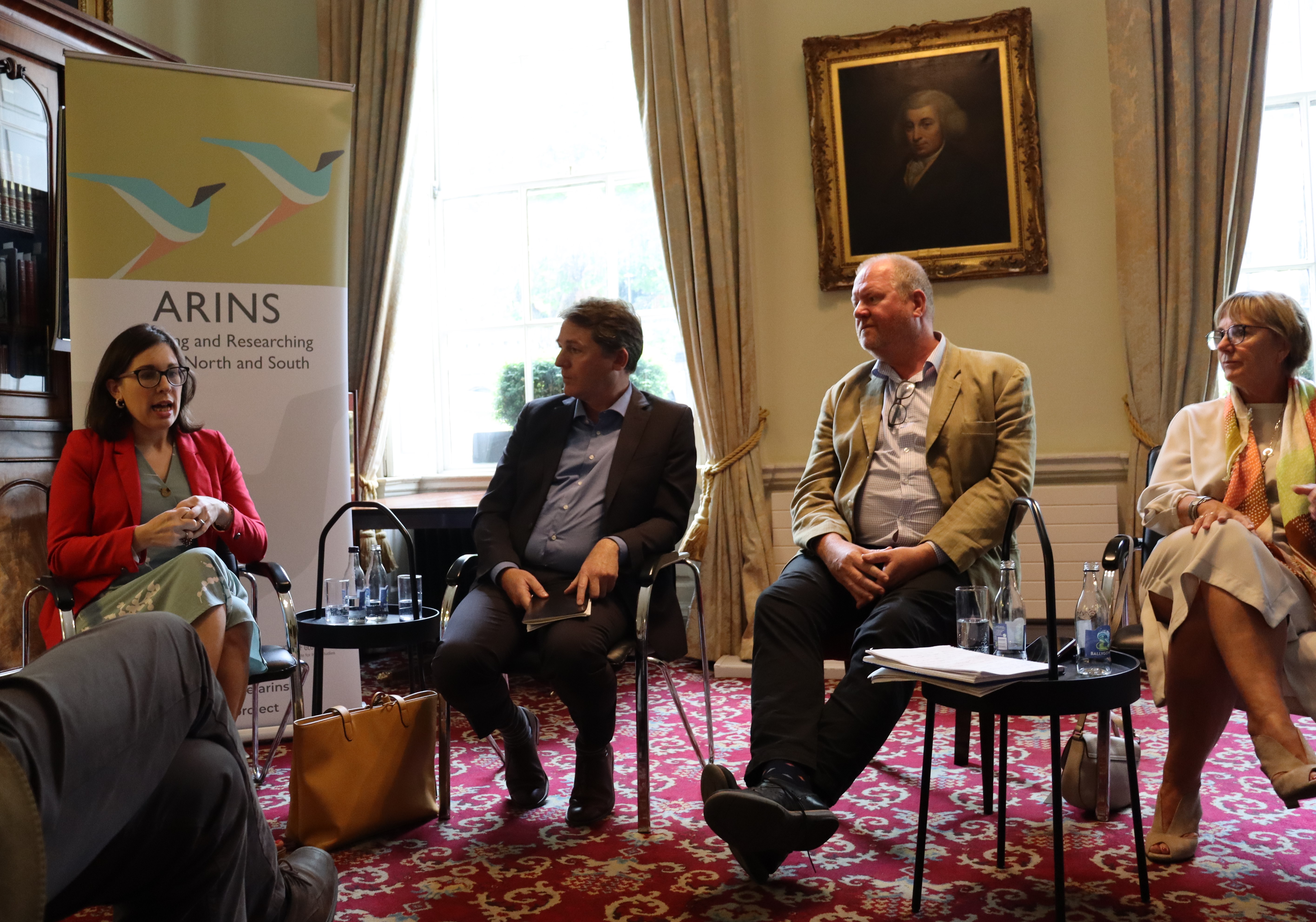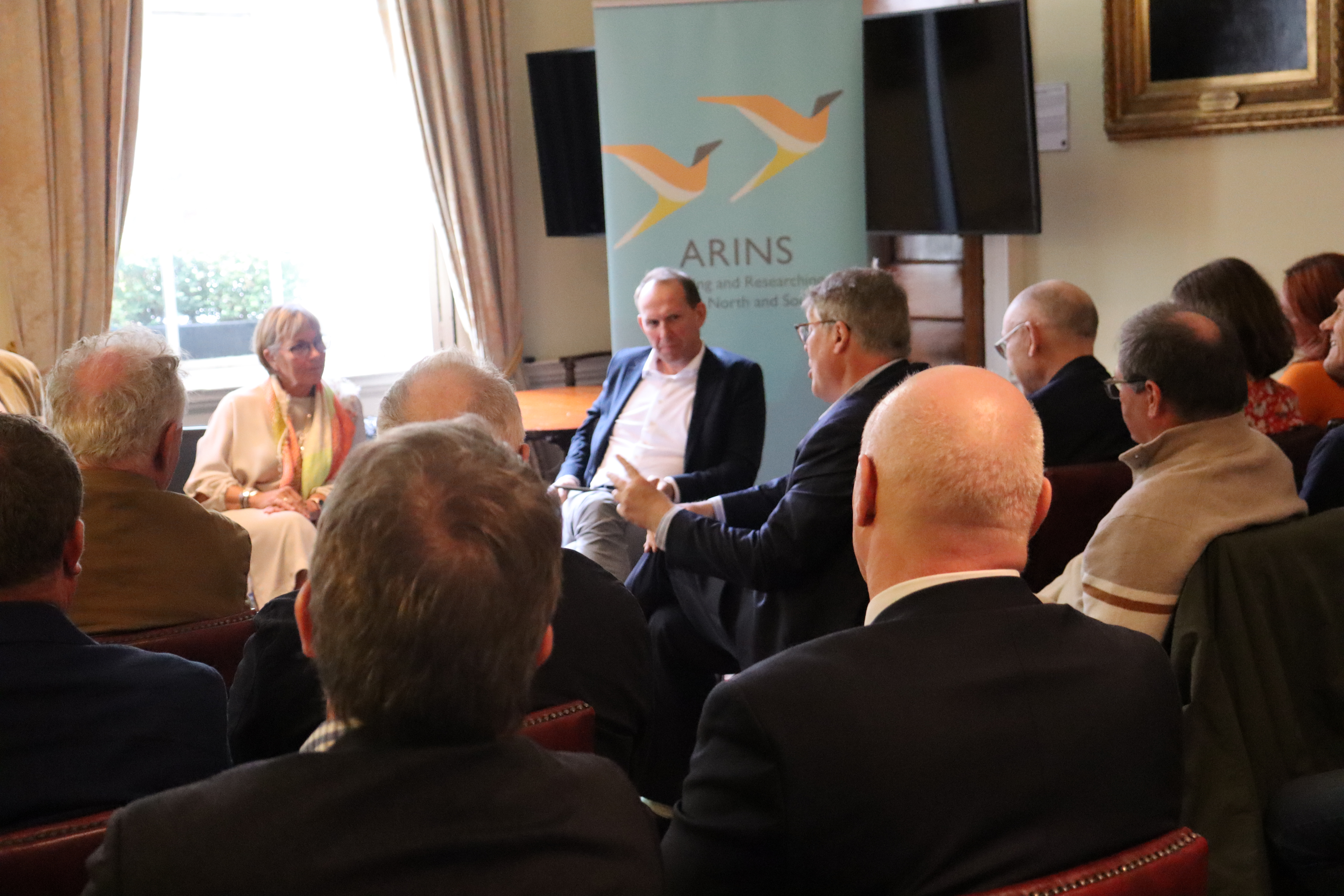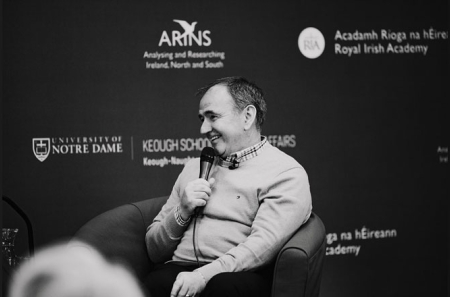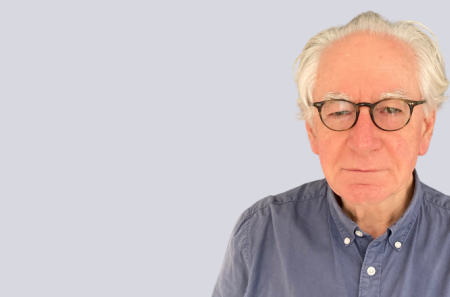
What’s in a name? ‘Nordies’ and ‘Mexicans’
13 July 2023What terms can trigger? How have identities been shaped or reshaped since the Troubles, by the telly, RTÉ, BBC and social media? Is there an invisible cultural border? Just some of the questions that emerged at ‘Nordies and Mexicans: Perceptions and Misperceptions of the Other: An ARINS panel discussion,’, 12 July 2023
The term ‘Mexican’ – from the old song ‘South of the Border Down Mexico Way’ and used by northerners to describe their southern neighbours – is light-hearted and inoffensive, while ‘Nordie’ can be deeply offensive and condescending. A ‘peace dividend’ is apparent since 1998, though a ‘hard cultural border’ may be forming since Brexit, which leaves us little space for the new Irish and Diaspora Irish.
As for the shaping of identity, this begins in childhood when we pick out our favourite brand of ice cream.
Chaired by Martin Doyle, books editor of the Irish Times, the panellists were Síobhra Aiken, author and lecturer at the Department of Irish and Celtic Studies, Queen’s University Belfast; Barry McCrea, author and Professor of Literature at the University of Notre Dame; Julie Sinnamon, Chair of European Movement Ireland; and Nick Whelan, CEO of Dale Farm Ltd. While 12th July bonfires and effigies were lit around Northern Ireland in commemoration of the Battle of the Boyne (1690), speakers and audience members gathered in Dublin and discussed immense progress, a casual ‘othering’ of northern Irish people, and ‘two cultural zones, north and south’.
Moving south or moving north brings an opportunity to challenge misconceptions about the other community in a divided society on the shared island. In both cases, the arrival of fresh eyes can help to throw light on inequities which often prevail unnoticed for long-time residents of a jurisdiction. Stark differences between the education system ‘up north’ and ‘down south’, disparities in education outcomes and the pressures of early streaming in Northern Ireland were noted. The infamous ‘ElevenPlus’ or ‘transfer test’ was criticised by one speaker whose children recently went through the drill: ‘It’s a brutal exam. It’s a Leaving Cert for 11 year olds.’
The sectarian component of the exam was rigorously criticised: ‘There are two exams, one for Catholics and one for Protestants. It promotes segregation and this idea that there are two societies in Northern Ireland.’ (To date there have been two ElevenPlus tests. One for Catholic maintained schools and one for state schools. From November this year there will be a joint set of tests.)
The speakers and indeed audience participants had an experience of crossing a border to live ‘on the other side’; many claimed a ‘hybrid identity’ originating from a border town, or identified as Dubliners whose people came from the north.
‘You can judge any society, any nation, on the way it treats its minority,’ one speaker noted. ‘And people are capable of saying extraordinarily insulting things about northerners.’ Northerners are made conspicuous by virtue of the ‘harder consonants’ of their accent. ‘In the south we think there is only one kind of Irishness. We feel that northern Irishness is not just inauthentic, but somehow threatening. Irish identity is fragile, because the Irish state and its institutions are relatively new.’
‘In many ways the north invigorated and created Irish culture,’ noted the speaker, arguing that in the 1960s and ’70s figures such as the Clancy Brothers (member Tommy Makem came from County Armagh), Seamus Heaney and the Field Day journal helped create a porous relationship between north and south.
The speaker suggested a ‘hard cultural border’ has since emerged, and two distinct ‘cultural zones’. Sport too can play a uniting and dividing role, and speakers noted the influence of both the GAA and IRFU, both all-Ireland sporting bodies. Even when it comes to taste, choice of brands can be divided between north and south – a preference for Dale Farm ice cream in the north and HB in the south a case in point: ‘There are still two societies, and two brands for each society’.
It is more than possible this casual othering comes from a place of fear. The legacy of the Troubles and the ‘whiff of ArmaLite’ was mentioned. One attendee whose Dublin parents came from Antrim remarked that ‘It was only after the troubles began in 1969 that my father was asked where he came from.’
A speaker described their expectations on moving up north, of it being a ‘half-way house between English culture and Irish culture.’ What they found was a brilliant workforce with a generational legacy of hard work, highly educated, with a great resilience.
However, they noted, ‘It’s fundamentally an advantage to be based here rather than up north when it comes to state support, where the focus can be on constitutional and tribal politics rather than on driving prosperity.’
The panellists discussed their preconceptions of about the neighbouring jurisdiction, in contrast to their lived experience. One speaker recalled the 1970s contraceptive trains, which brought a group of feminist activists to Belfast to buy birth control pills. Things have since transformed socially in Ireland, which has legalised for gay marriage and abortion.
For many Irish people from the south, visiting Northern Ireland was not part of growing up, aside from a shopping trip to Newry, Co. Down. The transition to living there was described as difficult and at times alienating.
‘It’s a wonderful place to be if you have money and a really tough place to be from a lifestyle point of view.’
Northerners are perceived as prioritising ‘family, farm and church’, as being direct, straight forward and ‘straight talkers.’ One speaker observed the ‘lack of fudging’ among Northerners, while in the south they had become accustomed to the ‘wink and the nod’. It was even suggested that the Belfast Agreement was come to by deal-makers with an ability to ‘fudge’ the details, without which it might not have come about.
Language too reflects identity conceptions and misconceptions, echoing the work of Roisin Costello on language politics [read article]. There is a rebirth in Irish language interest in the north, with TG4 launching their children’s TV channel, the Belfast Gaeltacht, and seven primary schools teaching through Irish in west Belfast.
And yet, as one speaker noted, the Irish language department at Queen’s struggles to be visible in a vast university with competing concerns. The speaker noticed, for example, the lack of signage for the department. This is despite Queen’s University’s connection with one of the longest running Irish language societies in the world – An Cumann Gaelach, established in 1906.
Belfast may be considered the cheapest city in the United Kingdom, but for more than one speaker, the most striking facet of life upon moving up north was poverty. The discrepancy in quality of life between north and south has been outlined in a 2021 study by Adele Bergin and Seamus McGuinness [read article]. Life expectancy is lower in the north of Ireland, and it was noted that in the north, 74 per cent of 15 to 19 year olds are currently in education, while in the south the figure is over 90 per cent. (See article by Anne Devlin and Seamus McGuinness). The related problem of ‘digital poverty’ among young people further hinders education.
Since the Good Friday Agreement, has there been such a thing as a ‘peace dividend’? The question was put as to whether peace has brought prosperity, or greater investment. A speaker noted that following the Troubles in the North, there were great risks for multinationals looking to invest in Northern Ireland. It was recalled anecdotally that in 1993 employees from one multinational (which was not named) were due to stay at the Stormont Hotel just before it was bombed.
After 1998, a wave of north-south bodies were established, leadership programmes encouraged, and initiatives harnessing north-south co-operation. This and the Shared Island initiative has harnessed institutional commitments to developing the economy, and attracting Foreign Direct Investment.
Today there is a vibrant technology start-up scene in the North, with great opportunities for employment encouraging young people a to stay in the north, and enticing those who have gone further afield to return home. A speaker highlighted the pleasant surprise of a more affordable property market: ‘I can buy a house in the north with three months payslips – my friends have no opportunity to buy in Dublin.’
The Chatham House Rule was observed, and quotes have been anonymised.


To find out more about ARINS – Analysing and Researching Ireland North and South – see arinsproject.com



